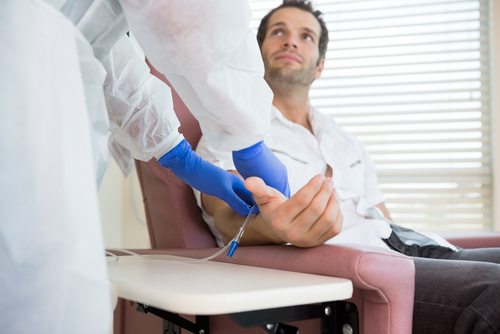More Curative Bone Marrow Transplants are Successful When Patients Given Double the Radiation Beforehand, Study Says

The success rate of bone marrow transplants for patients with sickle cell disease or beta thalassemia, from only “half-matched” donors, increased by doubling the radiation delivered to patients’ bodies before the transplants, a John Hopkins University study shows.
The study, “Effect of increased dose of total body irradiation on graft failure associated with HLA-haploidentical transplantation in patients with severe haemoglobinopathies: a prospective clinical trial,” was published in the journal The Lancet Haematology.
Sickle cell disease can potentially be cured with bone marrow transplants, but the strategy has been of limited use due to some constraints, namely the need to match the donor and the recipient for protein markers called human leukocyte antigens (HLA), a set of proteins that can trigger an immune system response. Each person carries a unique set of these proteins, which means that matching potential organ donors and recipients requires thorough testing to check that their HLAs are compatible.
Without a complete match, the immune system of the recipient may recognize the transplanted cells as foreign, triggering an immune system attack that destroys the donor cells.
The chances of finding fully compatible donors — usually siblings — to sickle cell disease recipients in need of a transplant is less than 15 percent.
In 2012, researchers at John Hopkins developed a strategy that involved using a much less aggressive combination of chemotherapy and/or radiation (non-myeloablative) to prepare a patient for a transplant, followed by treatment with an immunosuppressant. This allowed patients to receive transplants from relatives with only a 50 percent match. Moreover, the strategy reduced the risk of graft-versus-host disease, which happens when the recipient’s body sees the transplanted cells as foreign and then reacts against them.
While this strategy expanded the donor pool, the success rate of these transplants was 50 percent.
To boost the transplant success rate, the researchers developed a new strategy where patients received doses of chemotherapy and radiation to the entire body — the aim was to get rid of the immune cells that may mount an attack against donor cells — before the transplant.
The dose of radiation delivered was double what was used in the first strategy — from 200 centigray (cGy) to 400 cGy. Although higher, 400 cGy was still a relatively small amount of radiation that’s well-tolerated.
The researchers tested this new strategy in a Phase 2 trial (NCT00489281) which enrolled 17 patients, with a median age of 16. Twelve of the patients had sickle cell disease, and five had beta thalassemia, a related blood disorder.
Patients received a bone marrow transplant from a half-match donor — a sibling, mother, father, or aunt in one case — and all underwent treatment with the immunosuppressant cyclophosphamide, which is routinely used to prevent graft-versus-host disease.
The blood of every patient was tested to determine the success of the transplant, which was done by measuring the amount of DNA from the donor that was present in the patient’s blood cells — a chimera. Researchers evaluated the patients’ blood at day 30, 60, and 180, and one year after the transplant.
The results showed that all the patients, except one with sickle cell disease, had a successful transplant. Thirteen of 17 patients achieved full donor chimerism, and three had mixed donor-host chimerism.
Five patients eventually developed graft-versus-host disease, but the condition was resolved in all the cases.
At the time of the analysis, three patients were continuing the immunosuppressive treatment. All patients with a successful transplant showed a significant reduction or complete resolution of their symptoms. For those with sickle cell disease, this meant no pain crises, one of the disease hallmarks, and beta thalassemia patients didn’t require more blood transfusions.
“These latest findings add to an extensive and growing body of evidence supporting the safety and effectiveness of half-matched bone marrow transplants,” Richard Jones, MD, director of the Johns Hopkins Kimmel Cancer Center bone marrow transplantation program, and one of the study’s authors said in a press release.
“We have performed more than 1,000 half-matched bone marrow transplants, and our clinical studies have proved so successful, with safety and toxicity comparable to matched transplants, that half-identical transplants must be made available to more patients as a curative option,” he added.
These results show that “increasing total body irradiation to 400 cGy substantially reduced graft failure while maintaining the safety” of the transplant, the researchers wrote.
“This curative approach should no longer be restricted to patients with HLA-matched donors,” the study concluded.






